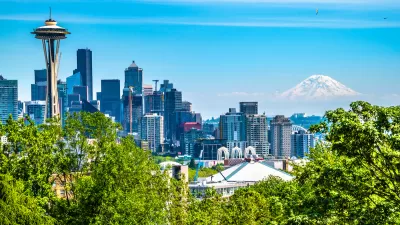Adrian Benepe was recently announced as the recipient of the 2014 Olmsted Medal. Like it or not, the well-deserved and appropriate recognition is one more in the seemingly endless list of honors for the transformation of New York's urban parks.

Accolades just keep coming for the ongoing renaissance taking place in New York City’s park system. The American Society of Landscape Architects (ASLA) recently added themselves to the list of fans once again by announcing that the Friends of the High Line will receive the 2014 Medal of Excellence, and Adrian Benepe—the former NYC Park Commissioner and current Senior Vice President and Director of City Park Development for the Trust for Public Land—the prestigious Olmsted Medal, which recognizes environmental leadership, vision, and stewardship. I discussed my admiration for the Friends of the High Line founders Josh David and Robert Hammond in a previous post, and now it is Benepe’s turn for praise.
A lot was made of Benepe’s legacy in New York once it became known he would be stepping down in 2013. Under his decade-long leadership, over 700 acres of spectacular new parks were added to the existing 28,000 acres that spread across all five boroughs. The list of parks created, planned, restored and improved while he was in charge includes the High Line, Brooklyn Bridge Park, Teardrop Park, the continued transformation of the Hudson River Park and the entire West Side waterfront in Manhattan, Lakeside in Prospect Park, the restoration of Fort Totten Park in Queens, the genesis and development of the innovative Fresh Kills Park on Staten Island, and the Shoelace Park Master Plan for the Bronx River, among many others. This nearly unprecedented record puts his influence on New York’s urban realm right up there with the 20th century “master builder” Robert Moses—whose legacy as Park Commissioner is a bit more controversial—and the honor’s namesake: Frederick Law Olmsted.

Without insinuating that Benepe is the second coming of Olmsted or anything, it is worth noting the parallels between their careers in New York. Both were writers before becoming creators of urban landscapes. Neither was trained in design but became experts in its language and practice from collaboration with others: Olmsted through his early partnership with the architect Calvert Vaux, and Benepe from close interaction with the many landscape architects and designers he engaged for park projects. Each was responsible for raising the profile of landscape architecture, and bridging the considerable perception gap between what is urban and what is nature. Perhaps the most valuable point on which their careers align, however, is how they dramatically transformed New York City, improved the lives of its residents, and created examples by which other cities could leverage exceptional parks of their own.
Benepe’s ultimate legacy in New York will be defined by more than just built work. His ecologically focused policies (which obviously reflect on his former boss, Michael Bloomberg, as well) and push for better long-term maintenance have established a culture of sustainability that runs far deeper than a slogan or ambiguously defined term in a mission statement. His promotion of green infrastructure initiatives and tree-planting programs has helped to convey the critical reality that even the densest cities are, in fact, functioning components of broader landscape systems.

Increased acreage of parkland is, of course, important, as is the improved efficiency of stormwater management and the benefits associated with an exponential growth in the urban tree canopy. Equally important to the work we see in New York, however, is the sustained level of quality of design and construction that has been achieved city-wide. It takes solid leadership to make this happen; leadership from people who understand that design matters, and that a healthy human society is inextricably linked to a healthy urban ecology. New York City has, thankfully, had such leadership, much of which can be attributed to Benepe. Is everything perfect? Of course not. As with any public park system, there will be challenges with funding, operations and maintenance that must constantly be dealt with.
But it is pretty darned impressive.

Upon leaving his position, Benepe spoke to themes applicable to cities everywhere when he laid out in a New York Times op-ed what he sees still needing be done in NYC:
“Opportunities remain to convert brownfields and abandoned structures, like a railroad in Queens, into parks and greenways. New flood control systems will allow for ecological and recreational space. The natural infrastructure will also require attention: trees play a huge role in cleaning the air and cooling the city, but they require more inspection and maintenance. The 10,000 acres of forests, meadows and wetlands that comprise the natural areas of city parks must be monitored and maintained, so that they thrive as habitat for animals and respite for humans. Most important, the people of New York must engage in the lives of their parks with a fierce passion - ensuring the future of the city for our children and theirs.”

I realize that some people out there are tired of hearing and reading about urban design, architecture and landscape architecture presented through the restrictive lens of New York City and its accomplishments. It has been a cause célèbre in the planning and design-oriented blogosphere and other social media for a long time now. Other cities across the country are certainly getting well-deserved recognition for new parks and urban improvements, but it is at a different scale. They just do not present the same magnitude of things to talk about...yet. When a monumental transformation occurs, such as the one we have seen in New York City over the past few years, the potential story lines can go on for a long time.
As far as I am concerned, keep the accolades coming.

Depopulation Patterns Get Weird
A recent ranking of “declining” cities heavily features some of the most expensive cities in the country — including New York City and a half-dozen in the San Francisco Bay Area.

California Exodus: Population Drops Below 39 Million
Never mind the 40 million that demographers predicted the Golden State would reach by 2018. The state's population dipped below 39 million to 38.965 million last July, according to Census data released in March, the lowest since 2015.

Pennsylvania Mall Conversion Bill Passes House
If passed, the bill would promote the adaptive reuse of defunct commercial buildings.

Google Maps Introduces New Transit, EV Features
It will now be easier to find electric car charging stations and transit options.

Ohio Lawmakers Propose Incentivizing Housing Production
A proposed bill would take a carrot approach to stimulating housing production through a grant program that would reward cities that implement pro-housing policies.

Chicago Awarded $2M Reconnecting Communities Grant
Community advocates say the city’s plan may not do enough to reverse the negative impacts of a major expressway.
City of Costa Mesa
Licking County
Barrett Planning Group LLC
HUD's Office of Policy Development and Research
Mpact Transit + Community
HUD's Office of Policy Development and Research
City of Universal City TX
ULI Northwest Arkansas
Town of Zionsville
Write for Planetizen
Urban Design for Planners 1: Software Tools
This six-course series explores essential urban design concepts using open source software and equips planners with the tools they need to participate fully in the urban design process.
Planning for Universal Design
Learn the tools for implementing Universal Design in planning regulations.


























